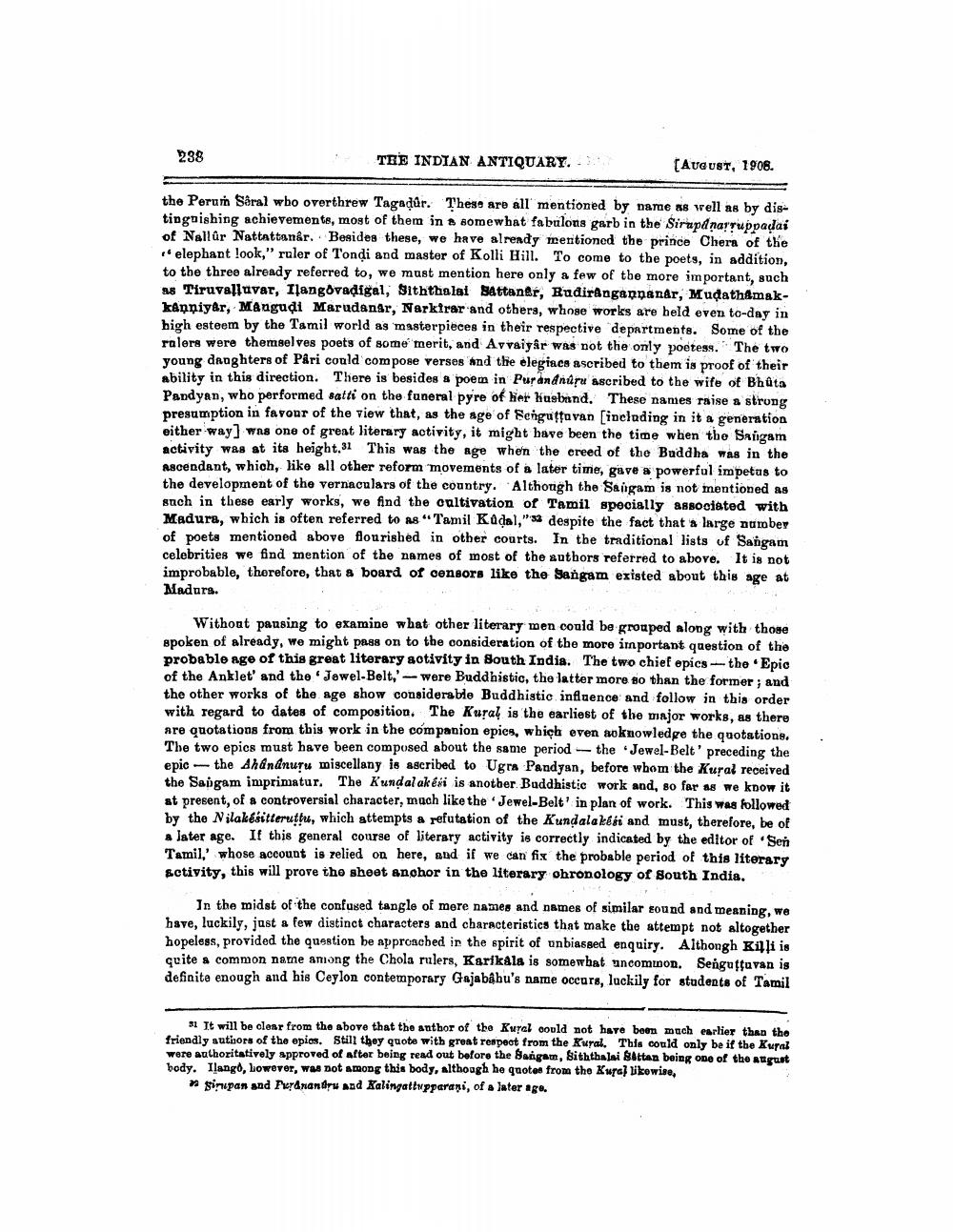________________
238
TEE INDIAN ANTIQUARY.
(AUGUST, 1906.
the Perun Säral wbo overthrew Tagađúr. These are all' mentioned by name as well as by distinguishing achievements, most of them in somewhat fabulons garb in the Sirupánartuppadai of Nallur Nattattanar. . Besides these, we have already mentioned the prince Chera of the ** elephant look," ruler of Tondi and master of Kolli Hill. To come to the poets, in addition, to the three already referred to, we must mention here only a few of the more important, such 88 Tiruvalluvar, Ilangovadigal, Siththalal Battaner, Rudirangannanår, Mudathamakkanniyar, Mangudi Marudangr, Narktrar and others, whose works are held even to-day in high esteem by the Tamil world as masterpieces in their respective departments. Some of the ralers were themselves poets of some merit, and Avvaiyar was not the only poetess. The two young daughters of Pâri could compose verses and the elegiacs ascribed to them is proof of their ability in this direction. There is besides a poem in Purandnúru ascribed to the wife of Bhuta Pandyan, who performed salti on the funeral pyre of her husband. These names raise a strong presumption in favour of the view that, as the age of Senguttavan (including in it a generation either way] was one of great literary activity, it might have been the time when the Sangam activity was at its height,31 This was the age when the creed of the Buddha was in the Ascendant, which, like all other reform movements of a later time, gave a powerful impetus to the development of the vernaculars of the country. Although the Sangam is not mentioned as sach in these early works, we find the cultivation of Tamil specially associated with Madura, which is often referred to as "Tamil Kadal," despite the fact that a large number of poets mentioned above flourished in other courts. In the traditional lists of Sangam celebrities we find mention of the names of most of the authors referred to above. It is not improbable, therefore, that a board of censors like the Sangam existed about this age at Madurs.
Without pausing to examine what other literary men could be grouped along with those spoken of already, We might pas8 on to the consideration of the more important question of the probable age of this great literary activity in South India. The two chief epics - the Epic of the Anklet' and the Jewel-Belt,' were Buddhistic, the latter more so than the former; and the other works of the age show considerable Buddhistic influence and follow in this order with regard to dates of composition. The Kural is the earliest of the major works, as there are quotations from this work in the companion epics, which even acknowledge the quotations. The two epics must have been composed about the same period the Jewel-Belt' preceding the epic the Ahåndnuru miscellany is ascribed to Ugra Pandyan, before whom the Kural received the Sangam imprimatur. The Kundalak éxi is another Buddhistic work and, so far as we know it st present, of a controversial character, much like the Jewel-Belt' in plan of work. This was followed by the Nilakésitterutfu, which attempts a refutation of the Kundalakozi and must, therefore, be of a later age. If this general course of literary activity is correctly indicated by the editor of Sen Tamil,' whose account is relied on here, and if we can fix the probable period of this literary activity, this will prove the sheet anchor in the literary ohronology of South India.
In the midst of the confused tangle of mere names and names of similar sound and meaning, we have, luckily, jast a few distinct characters and characteristics that make the attempt not altogether hopeless, provided the question be approached in the spirit of unbiaseed enquiry. Althongh Kili is quite a common name among the Chola rulers, Karikala is somewhat uncommon. Senguțfuvan is definita enough and his Ceylon contemporary Gajabâbu's name occurs, luckily for students of Tamil
Bl It will be clear from the above that the anthor of the Kural could not have been much earlier than the friendly authors of the epics. Still they quote with great respect from the Kural. This could only be if the Kural were authoritatively approved of after being read out before the Sangau, Siththalai Bottan being one of the August body. Ilango, Lowever, was not among this body, although he quotes from the Kural likewise,
n sinipan and Pwednandu and Kalingattnpparani, of a later ago




